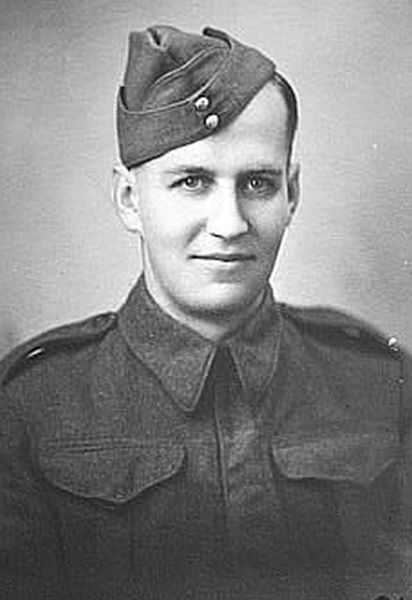Tuttle, Norman Eugene
- Date of birth:
- August 20th, 1916 (London/Ontario, Canada)
- Date of death:
- March 16th, 1964
- Service number:
- A.5021B
- Nationality:
- Canadian
Biography
Norman Eugene Tuttle was married to Cora Kathleen Shannon. The couple had a son (Norman) and two daughters (Shannon and Catherine).
The decorations of Norman Eugene Tuttle are on display in the For Freedom Museum in Knokke-Heist.

Norman Eugene Tuttle (3rd from right) in 1945 in front of Buckingham Palace
Do you have more information about this person? Inform us!
- Period:
- Second World War (1939-1945)
- Rank:
- Acting Corporal
- Unit:
- No.12 Platoon, B Company, 1st Battalion, The Highland Light Infantry of Canada, 9th Canadian Infantry Brigade, 3rd Canadian Infantry Division, Canadian Army
- Awarded on:
- April 12th, 1945
- Awarded for:
- Operation Switchback
On the 1st November 1944, Corporal Norman Eugene Tuttle was acting in command of 12 Platoon, "B" Company, Highland Light Infantry of Canada. As a result of casualties the Platoon was at that time 23 men strong.
The battle of the Lower Scheldt Estuary was nearing its close and the enemy had been forced into a pocket in the area of Heyst, Knocke-sur-Mer and "Little Tobruk", the German fortress along the Scheldt east of Knock-sur-Mer. Ninth Canadian Infantry Brigade was ordered to clear this pocket.
The Highland Light Infantry of Canada was given the task of clearing up the east end of Knocke-sur-Mer and the "Little Tobruk" fortress area which would allow the remainder of the brigade to advance west to take out the balance of the enemy pocket.
"B" Company was given the task of attacking "Little Tobruk", the rapid capture of which was essential to the success of the battalion battle and the subsequent completion of the battalion task.
"Little Tobruk" was a self-contained fortress. It consisted of mutually supporting concrete and earth work positions situated on the high sand dunes just inland from the sea, and supplemented by normal infantry dug-in positions. The perimeter of the fortress was protected, from the landward side, by a belt of heavy concertina wire 30 feet in depth, and 100 yards of flat open ground, heavily mined.
"B" Company advance was held up when 12 Platoon, in the lead, came under intense enemy machine gun fire from the fortress. The only approach was across the minefield and the wire, directly through the enemy fire.
Corporal Norman Eugene Tuttle, seized the initiative. He sited the Brens of his platoon to provide covering fire and, with only this support and smoke from the 2 inch mortar, he crawled forward through the enemy fire. Using his bayonet to prod for mines he picked a path through the minefield to the barbed wire. The enemy machine guns continued firing through the smoke, the bullets landing throughout the wired area around Corporal Tuttle.
Completely ignoring the enemy fire, Corporal Tuttle worked for twenty minutes cutting his way through the wire. He then called to his platoon to follow him through the gap. His men, inspired by his act, rushed through behind him and charged the enemy position. Corporal Tuttle, in the lead, threw two 36 grenades into the first pillboxes killing 5 Germans and wounding 12. He then led his platoon through the maze of wire, entrenchments, earthworks and pillboxes to force the surrender of a Lieutenant-Colonel, seven other officers and approximately 250 other ranks. The outstanding skill with which he commanded the platoon during this action contributed materially to the ultimate success of the battalion and the Brigade operation.
Corporal Tuttle's complete disregard for his own safety and courageous leadership were an inspiration to his comrades and will remain for all time and outstanding example of the high tradition of valour of the Canadian Army.
Original recommendation had been for a Victoria Cross but downgraded by General B.L.M. Montgomery who substituted a Distinguished Conduct Medal. Royal approval was given on March 24th, 1945.
Sources
- Photo 1: Shelly Tuttle Kelly
- - ZUEHLKE, M., Terrible Victory, Douglas & McIntyre Publishers Inc., Vancouver, Canada, 2008.
- National Defence and the Canadian Forces
- Recommendation DCM
- Supplement to The London Gazette of 12 april 1945, Issue 37027, Page 1944



